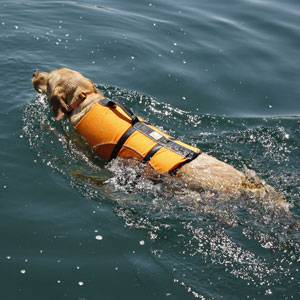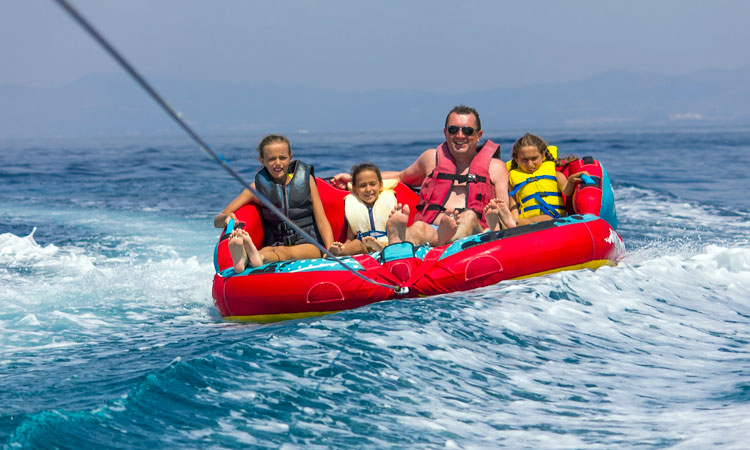
When the whole family is ready for a fun-filled day on the water, there’s nothing better than tubing behind a boat. Maybe you learned to love tubing behind the family boat when you were a kid and can’t wait to create memories with your own children. Or, maybe you’re brand new to the sport.
Either way, becoming familiar with tubing safety before you hit the water is a smart idea. Towing a tube behind your boat is a huge responsibility. Of course, every water sport comes with some bumps and bruises, but with the proper safety precautions, there’s no reason everyone can’t be safe and have fun at the same time.
Here are our top tips for towing tubers behind your boat safely!
See Also: 6 Jet Ski Tubing Advantages
Table of Contents
Boat Tubing Tips
#1 – Be Safety Aware
Tubing safety starts with simple awareness. Some of the most common tubing injuries happen when tubers collide with each other or debris floating on the water. Water impact injuries, where the passenger is thrown off the tube and hits the water, are also quite common and can be serious.
When talking to your riders about tubing safety, keep these things in mind. Children often take risks they shouldn’t, so be sure they’re aware of the rules and dangers. Teach them to watch for floating debris and other obstacles and have a signal to use when they want you to slow down or stop, such as thumbs down.
Never tow more than one tube at the same time. If you want to have multiple riders in the water at once, choose a multi-rider tube and ensure that everyone wears a safety helmet.
And, as the boat’s driver, awareness is your top priority. Watch for hazards in the water, including debris and wakes from other boats. Don’t take unsafe risks to make the ride more thrilling for your passenger.
Related: Boating While Pregnant (Do’s and Don’ts)
#2 – Follow a Pre-Tubing Checklist
A good towable tube should have plenty of handles and be made to accommodate the number of passengers you’ll be towing. Never try to tow more than one passenger on a tube meant for a single rider.
Here’s our essential pre-tubing checklist to perform before every outing:
- Inspect the tube carefully for rips, punctures, or wear and tear that might cause the tube to deflate or pop when you have a rider in the water.
- Ensure that the tube is properly inflated to the correct PSI, according to the manufacturer’s instructions.
- Check your tow rope and connectors for any signs of damage or wear and tear. Ensure that it’s properly secured, free of knots and tangles, and has the appropriate capacity for the number of people you plan on towing.
- Add a Booster Ball to your tow line to help keep it out of the water. This may stop your rider from being jerked and possibly thrown off the tube when the slack is removed. It can also help prevent submarining.
#3 – Ensure That Your Rider is Wearing the Right Life Jacket
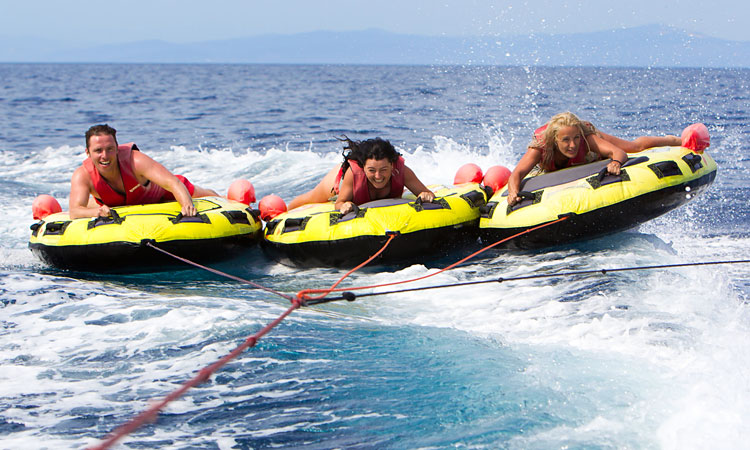
Life jackets are a must for keeping riders afloat if they’re knocked off the tube, and they’re required by law for kids in most states. Most tubers wind up in the water at some point, but it’s not a big deal if they’re wearing a USCG approved life jacket.
Before you leave the dock, make sure there’s a lifejacket on board that’s suitable for every rider, according to their size, height, and weight. Ensure that the life jacket fits comfortably around the arms and chest.
Lifejackets for small children should also have a crotch strap to prevent them from riding up in the water. Ensure that all buckles snap and adjust properly. You want the life jacket to be comfortable, but not so loose that it slips over the head if the rider hits the water hard.
#4 – Choose the Right Helmet for Your Rider
Every tuber should also wear a helmet when they’re on the water. Helmets protect tubers during collisions with other riders, protect against hard impacts with debris and other obstacles, and protect the eardrums when riders hit the water hard.
Ensure that each rider has a helmet that’s designed for water sports, fits them correctly, and has ear guards. Remember, you’re not lazily floating down a river or chilling in a floating island on the lake. Instead, you’re being towed by a powerboat at fairly high speeds.
#5 – Have Your Riders Wear Goggles
Goggles will protect your rider’s eyes from flying debris, bugs, and water. Make sure they fit the rider correctly and provide a good seal.
#6 – Know Your Rider
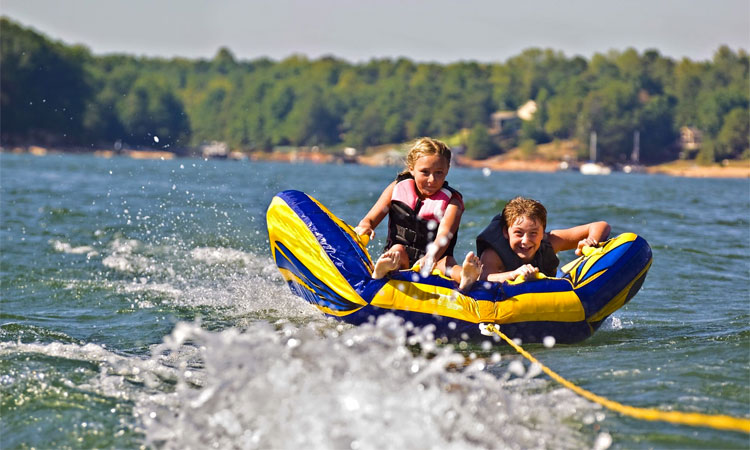
Knowing your rider is just as important as being safety aware. Before you pull a rider on a tube, think about their age, experience level, health condition, and familiarity with the equipment. Will there be one rider or multiple riders?
Every situation is different, but in general, the younger or more inexperienced the rider is, the slower you should go. Take it easier when going around turns or hitting waves and wakes. The same goes for when you’re towing multiple riders.
If you’re taking someone else’s child tubing behind a boat, make sure you have parental permission first. Ask about the child’s swimming abilities and tubing experience. It might also be a good idea to have a signed release from the parents, especially if they aren’t going to be joining you.
See Also: 15 Fun Things for Kids to Do While Boating
#7 – Have a Spotter
You should always have an extra passenger on board the boat who can act as a spotter when you have a tuber in the water. Their job is to let you know if the tuber has an accident or some other issue.
They’re also an extra set of eyes to help you watch for other boats, debris, or strong wakes that you need to avoid to keep your rider safe. Having a spotter allows you to keep your eyes focused on where you’re headed, rather than constantly looking back to check on your tuber.
#8 – Know Your Boat
When you’re pulling tubers behind your boat, you need to know how it reacts. What is its towing capacity? Can it pull more than one rider safely? Does it accelerate fast or slow?
Read your manual to ensure that you’re familiar with the manufacturer’s recommendations for towing a tube behind the boat. And take a test drive or two with an experienced rider to help you get accustomed to towing before you hit the water with inexperienced tubers.
#9 – Know the Rules of the Water
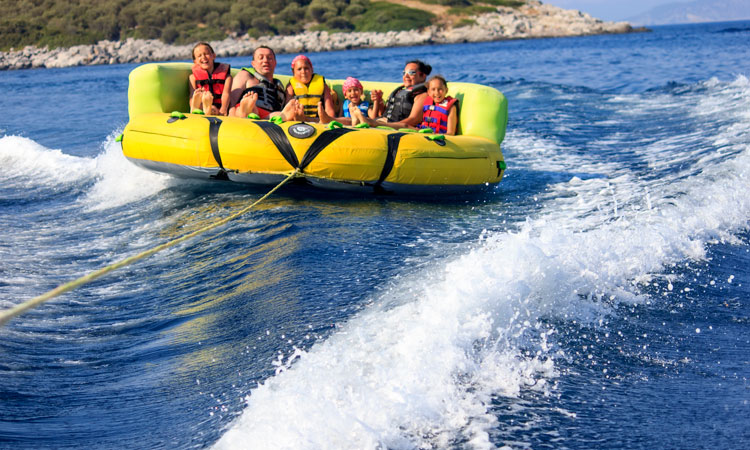
The rules of the water can differ from place to place, but chances are good that there will be regulations in place regarding towable tubes. It’s rare, but some areas might even require a special permit or fee.
Be sure to learn what they are before you head out on the water so there aren’t any surprises. The rules are in place for a reason and answering to law enforcement is never fun!
Related: How Flying Boating Tubes Became Illegal
#10 – Let Other Boaters Know You Have a Passenger in the Water
Flying an orange flag is the universal signal to other boaters that you have a passenger in the water. Your spotter should be in charge of raising the flag anytime a tuber is in the water, such as when boarding or leaving the tube, or any time a rider falls in.
And, be sure to turn your boat’s engine off when riders are swimming near the boat.
#11 – Have a Signal That Indicates Your Rider is Ready to Go
Having a signal that indicates your rider is ready to go is essential. You don’t want to take off too soon and send your rider flying. A simple thumbs-up will do.
Before you hit it, look for other boats in your area. Make sure their wakes have passed so that you don’t bounce your rider off the tube right away.
#12 – Accelerate the Right Way
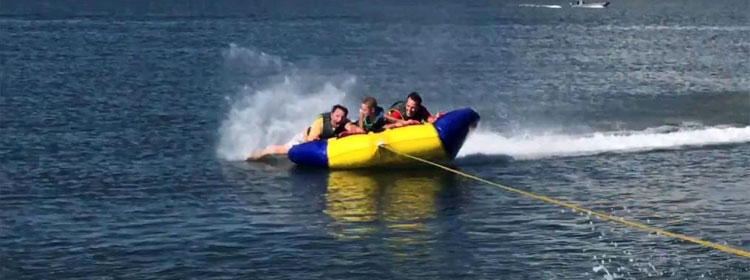
When towing a tube behind a boat, you should accelerate at a steady, gradual pace. If you accelerate too fast, they might not be able to hold on. If you accelerate too slowly, the drag might cause them to submarine.
Once you get up to an appropriate speed for your rider, try to keep it steady. Choose an area that’s not too crowded so there aren’t a lot of obstacles or wakes that could cause injury or throw your rider off.
#13 – Keep the Ride Fun, But Safe
When tubing behind a boat, the faster you go, the more thrilling the ride will be. And, the sharper the turn, the faster the tuber will fly from side to side. While high-speed turns can be fun, they’re also dangerous, especially for young or inexperienced riders.
Keep your speed below 26 knots and never execute turns when you’re close to the shore or other obstacles. If the rider loses his grip or your tow rope snaps, the rider could easily be thrown against a nearby object and get seriously injured.
Try driving in S-shaped patterns at a speed that’s comfortable for your rider, rather than making sharp turns. This will still be fun for the rider, but it’s much safer.
Some Final Thoughts
Remember that as the captain of your boat, the responsibility to use caution and safe judgment ultimately falls on you.
Tubing behind a boat is incredibly fun, as long as you use a durable tube intended for being towed (here are our recommendations), the right safety gear, and follow the safety rules outlined in this article.


